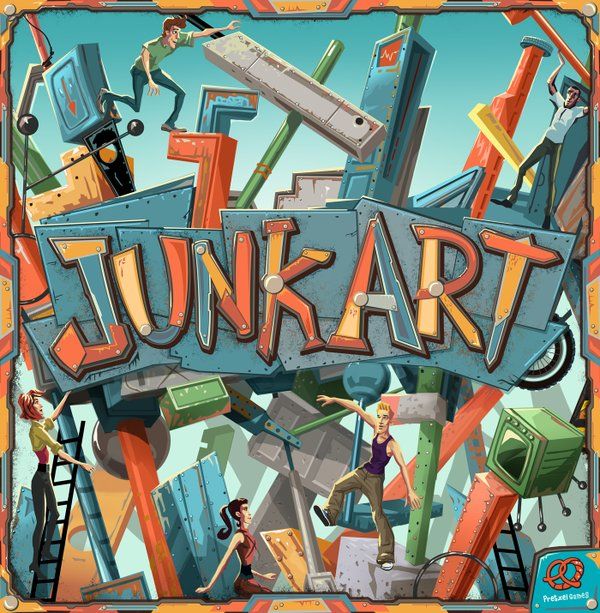How To Play: Junk Art – Setup, rule summary and strategy
To excel in Junk Art, grasp the nuances of piece shapes for fundamental stacking strategies. Master balancing to defy gravity as you stabilize your structure. Engage with adversaries through tactical play, predicting moves, and strategic card use. Excellence springs from synthesis of form, balance, and wit.

Overview
Welcome to our succinct guide on ‘How To Play Junk Art’ where we’re not just brushing over the game rules, but diving into watertight strategies for triumph! Ever dreamt of becoming a master artist with unconventional mediums? Whether you’ve dabbled with Junk Art before or you’re new, our guide, soaked in firsthand experiences, is your secret blueprint to outbalance, outsmart, and outplay your competitors for that sweet victory!
What’s in the Box?
- 60 Wooden Junk Art Pieces
- 60 Junk Art Cards
- 15 Fan Tokens
- As Many Paper Cities Boards as there Are Players
- 1 Start Player/Direction of Play Token
- 1 Rule Book
How To Play Junk Art: Rules Summary
Getting into ‘How To Play Junk Art’? It’s a game where creativity, balance, and a steady hand are key. But before you stack your way to success, let’s dive into the rules that set the stage for fun and competition.
Setup
- Place the base in front of you.
- Distribute artist cards to players.
- Prepare the art pieces following specific game mode.
Gameplay
- Draw and play art pieces per turn.
- Follow the chosen city card’s rules.
- Build upon your or others’ structures.
Winning
- Earn points for completed structures.
- Gain bonus achievements in some modes.
- The most points after all rounds wins.
Special Rules & Conditions
- Topple rules vary by city, adjust accordingly.
- ‘Frenzy’ play alters turn order dynamically.
- End-game conditions can shift – stay alert.
Best Junk Art Strategies
Mastering the Puzzle: Component Shapes in Junk Art
Understanding component shapes is pivotal when strategizing in Junk Art. Firstly, it’s about recognizing how each piece interacts spatially with its counterparts. Pieces come in quirky shapes, and some nest together like they’re soul mates from a timber block fairy tale, while others will collide and clash like bitter rivals.
Know Your Shapes
Begin by getting acquainted with each unique shape at your disposal—mentally categorize them.
Assess and Strategize
During the game, rapidly assess the given piece’s potential for stability or chaos.
Spatial Relations
Look beyond the immediate — forecast how it could affect future placements.
Mastering the Art of Balance in Junk Art
Mastering Junk Art isn’t just creativity; it’s about defying gravity with keen balancing techniques. Use my tried-and-tested strategies for stability.
Find the Fulcrum
- Identify pieces with natural pivot points.
- Evenly distribute weight around these points.
Counterbalance Effect
- Place heavy components low and centered.
- Add lighter pieces farther out from the center.
Adjusting on the Go
- Shift placements as you add more pieces for stability.
- React and realign after each new layer.
Mastering the Art of Rivalry in Junk Art
Understanding player interaction is crucial in Junk Art as it directly influences your strategy. Whether it’s a casual game night or a cutthroat session among seasoned players, knowing how to deal with opponents can give you the upper hand. Here’s how to thrive through interaction:
Anticipate Opponents’ Moves
- Examine their structures to forecast their needs, potentially blocking crucial plays.
Know When to Compete or Collaborate
- Strategically help or hinder others based on your position to gain advantages.
Effective Use of Action Cards
- Leverage action cards not just for your benefit but to disrupt others’ plans.
Always stay one step ahead; anticipate, plan, and react strategically to what others are doing. By mastering player interaction, you enhance your gameplay experience and your chances of becoming a Junk Art maestro.
Mastering the Art of Balance
Throughout our games of Junk Art, we’ve discovered that understanding the shapes, balancing with precision, and navigating player interactions are key to becoming a true Junk Art maestro. Remember: Every piece is a potential keystone, and versatility leads to victory. Each game is an opportunity for growth, so embrace the challenge, adapt to the ever-changing canvas, and, above all, have a blast creating your unpredictable masterpieces. Remember, the pinnacle of Junk Art isn’t just about winning; it’s about the fun and creative journey that gets you to the top!
Want to know what we think of Junk Art? Read our detailed review of Junk Art here

